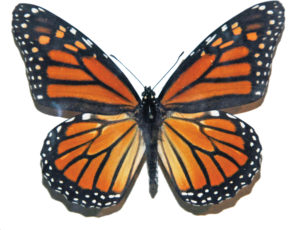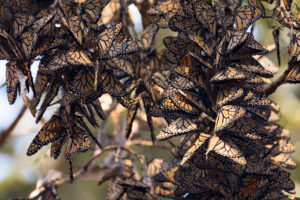Monarch butterfly populations in California’s coastal overwintering sites showed a slight — and surprising — rebound in 2013 after more than a decade of dwindling numbers.
The 2013 Western Monarch Thanksgiving Count tallied 211,275 monarchs at 162 sites from Sonoma County to San Diego County, up from 144,812 the year before.
Over the past two decades, the Western Monarch population has dramatically declined in California and the slight increase in this year’s count is an encouraging sign that the population is hanging on.
“We were bracing ourselves for that downward trend to continue this year,” said Mia Monroe, a Xerces Society volunteer who coordinates the yearly count. “So to have the population be a little higher and to have some sites really holding onto the monarchs is encouraging.”
For the Western Monarch Thanksgiving Count, volunteers across the state meticulously count scores of butterflies for a three-week period around Thanksgiving. In the Bay Area, about 20 volunteers participated in the 2013 count, Monroe said. The count focuses on the western monarch population, those west of the Rocky Mountains that overwinter in coastal California. In the spring, these monarchs will fly east to the Central Valley and the Sierra Nevada foothills, as well as north to Oregon and Washington, in search of milkweed on which to lay their eggs.

For the past few years, overwintering sites at the San Leandro Golf course and Ardenwood Historic Farm in Fremont have had relatively stable numbers, with around 5,000 at the golf course and 1,032 at the farm.
Natural Bridges State Beach in Santa Cruz showed the most surprising results this year: In 2012, the number of monarchs overwintering at Natural Bridges dropped to an all time low of just 500, but this year the number rose to 4,600 monarchs overwintering at the seaside eucalyptus grove.
“With all the fire and the drought I was really worried that we wouldn’t see so many monarchs this year,” said Martha Nitzberg, an interpretive specialist at Natural Bridges. “We were very pleased that it was a better population than last year.”
Nitzberg said that several changes at the park may have contributed to the higher number of monarchs overwintering at the grove. In 2012, the park’s scrub-jay population disrupted the monarchs, so much so that few butterflies stayed for the duration of winter. Since then, staff have re-landscaped various areas of the park to remove much of the lawn and watering systems, and perhaps make it less favorable to nesting scrub-jays. Several crows and an owl, were also seen at the park and may have contributed to the absence of the jays this year.
While populations at some overwintering sites were up and others were down, monarchs overall are at a fraction of their historic number. In 1997, the count’s inaugural year, more than 1.2 million monarchs were counted at 101 coastal California sites. By the following year the number had dropped to just 564,349 butterflies recorded.
Sarina Jepsen, the Xerces Society endangered species program director says that researchers are still trying to explain the decline, but issues such as loss of overwintering sites, loss of breeding habitat, the use of herbicides, and drought have contributed.
“I think that drought is the big one,” Jepsen said. “The most research to date has been done on that, and with climate change models predicting drought to worsen in the coming decades, that’s really concerning.”
A study by biologists Shawna Stevens and Dennis Frey in 2010 hypothesized that the increasing severity of drought across the West was correlated with the decline of monarch populations. Milkweed, the monarch’s host plant, is the only plant a female will lay eggs on and the only plant caterpillars will eat. A lack of rain has been shown to reduce milkweed biomass and shorten its summer availability, meaning if it is a particularly dry season there may be little milkweed available on which a female can lay her eggs.

In the West, monarchs typically migrate around Valentine’s Day, Monroe said, but this year there have been sightings of monarchs mating a month earlier than usual. This has raised concerns as to whether pregnant females will find milkweed available in the Santa Clara Valley or the Diablo foothills so early in the season. While the recent rain has been encouraging, it is too early to tell whether it will have made any difference for early mating monarchs.
“To be honest with you, we’re in our hold-our-breath mode,” Monroe said. “One of the things about monarchs is they breed not only monarchs, but hope — and with this rain the hope is that maybe the milkweed will emerge and maybe we’ll luck out.”
While the majority of the data for the annual count is collected during the Thanksgiving period, Monroe encourages volunteers to regularly visit overwintering sites and track changes — as they did, for example, during the cold snap in early December.
“Many people went out after the counts and we were reassured that most of the monarchs had made it through the freeze,” she said. “So the protective quality of the forest did the job.”
While California’s monarchs may be holding on, a new report from the World Wildlife Fund in Mexico, has found that the number of monarchs overwintering in Mexico’s Oyamel fir forest has reached an all-time low. The reports suggest that factors such as loss of habitat, climate change and use of insecticides have contributed to the decline.
While it is largely the eastern population of monarchs — those east of the Rocky Mountains — that migrates to Mexico, new evidence suggests that clusters from the western population may also make the long migration. In Arizona, a group of volunteers have been tagging monarchs during the summer to track their migration. While some of these butterflies have been documented in California, others have been found in Mexico. Biologists and volunteers are now trying to determine what factors may cause one monarch to migrate to California and another to Mexico, Monroe said.
“It shows you just how complex nature is,” she said. “The big lesson is, it’s not a simple story.”
To learn more about butterflies in the Bay Area check out this handy resource page.





